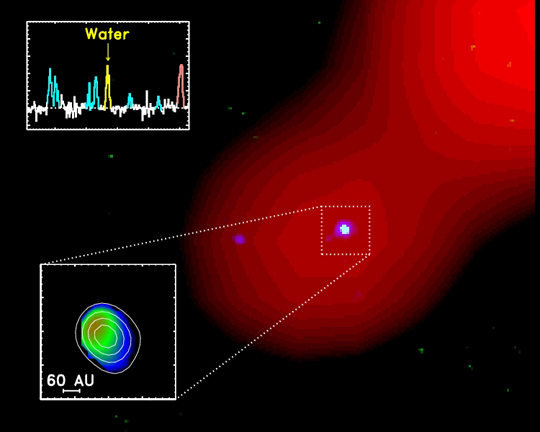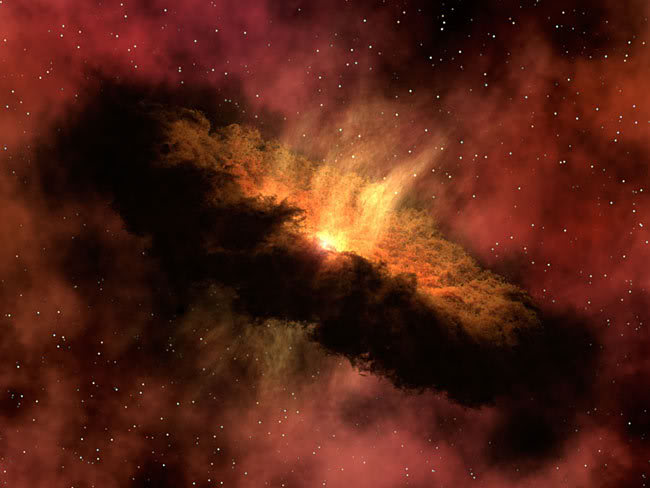News
First localisation of water in proto-planetary disk
Water is a key ingredient for life as we know it on Earth. Most of the water in the Earth's oceans likely originated in a tenuous cloud between the stars which collapsed to form our solar system. Exactly where the water was produced and how the molecules made their way from this giant cloud to tiny planets like Earth some 4.5 billion yr ago is one of the main questions in the study of our origins.
While astronomers cannot turn back the clock to observe our own young solar system, they can study planetary systems in formation around other nearby young stars.
|
|
|
Artist's concept of the young star NGC 1333 IRAS4B and its disk in which astronomers suppose planets will form. Credit: NASA/JPL-Caltech/R. Hurt (SSC) |
Because of obscuration by the large amounts of water in our own atmosphere, astronomical observations of normal water (H216O) require satellites such as the recently launched Herschel Space Observatory. However, about 1 in 500 water molecules in space contain the heavier 18O isotope. Some signatures from this heavier water (H218O) are able to penetrate the Earth's atmosphere and reach the IRAM telescopes. Since telescopes on Earth are much bigger and see a hundred times sharper than any existing satellites, this allows astronomers to zoom in on the forming stars and determine the location of water.
A team of astronomers - Jes Jørgensen at University of Bonn, Germany and Centre for Star and Planet Formation in Copenhagen, Denmark and Ewine van Dishoeck at Leiden Observatory, the Netherlands and the Max-Planck Institute fur Extraterrestrische Physik in Garching, Germany - used the IRAM Plateau de Bure Interferometer to look for water around a young star, NGC 1333 IRAS4B that formed only 10,000-50,000 years ago. The astronomers found that most of this steam around the young star is located within the inner 25 AU of the rotating disk. This distance corresponds approximately to the orbit of Neptune in our own solar system. Previous observations of this protostar had suggested that water vapour is pouring down from the cloud and accretes onto the disk.
The IRAM data show that the amount of water actually in the disk is a factor of hundred larger than in any such shocks - about 100 times more than the content of Earth's oceans. 'The water is likely located in a hot layer just above the disk midplane, where most of the available oxygen is driven into water by chemical reactions' says Ewine van Dishoeck. 'We now know that most water enters the disk in the form of ice around dust grains from the cold collapsing cloud, and that these “icy mantles” evaporate at the higher temperatures close to the young star.'
 |
|
Radio image of the star NGC 1333 IRAS4B observed with the IRAM Plateau de Bure Interferometer. The top inserted figure shows the spectral fingerprints of the water molecule. Credit: Jes K. Jørgensen and Ewine van Dishoeck |
'These observations of water vapour have opened up a whole new avenue to study water in young solar systems, complementary to that possible with satellites', says Jes Jørgensen, lead author on the paper. 'Only the IRAM Plateau de Bure Interferometer is currently able to catch and image these very weak signals of of the water isotopologue.
Moreover, the long wavelengths at which the Plateau operates allow us to see much deeper into the disk and we can thereby study the physical and chemical processes that control the early evolution of these disks that may set the stages for the eventual formation of planets.' Over the next 3 years, the Herschel Space Observatory will survey normal water in many star-forming clouds in our own and other galaxies. Combined with similar ground-based observations, astronomers will be able to determine exactly how much water is located where and at which stage of evolution of a young star.
Published in "The Astrophysical Journal", February 10, 2010.
Press release on the INSU/CNRS webpage
Contacts:
Karin Zacher
IRAM PR officer
Phone: +33 4 76 82 21 03
E-mail: zacheratiram.fr
Jes K. Jørgensen
Argelander-Institute for Astronomy, Univ. Bonn/
Centre for Star and Planet Formation
Natural History Museum of Denmark, University of Copenhagen
Øster Voldgade 5-7
Phone: +49 (0)1779 617015 (cell-phone)
E-mail: jes@snm.ku.dk
Ewine F. van Dishoeck
Leiden Observatory
P.O. Box 9513
2300 RA Leiden
The Netherlands
and Max-Planck Institut für Extraterrestrische Physik
Giessenbachstrasse
85748 Garching
Germany
E-mail: ewine@strw.leidenuniv.nl




